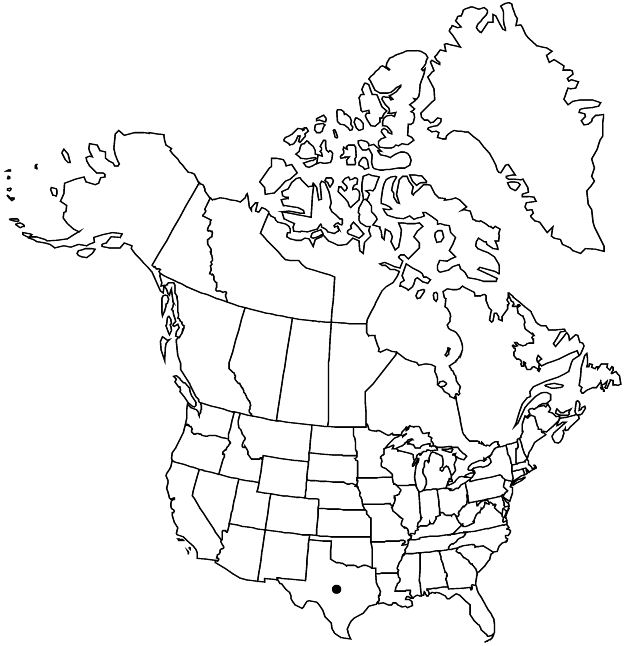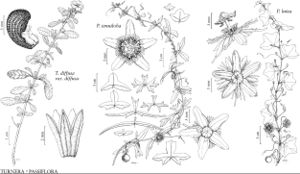Difference between revisions of "Passiflora tenuiloba"
Boston J. Nat. Hist. 6: 192. 1850.
FNA>Volume Importer |
imported>Volume Importer |
||
| (6 intermediate revisions by 2 users not shown) | |||
| Line 9: | Line 9: | ||
|special_status={{Treatment/ID/Special_status | |special_status={{Treatment/ID/Special_status | ||
|code=F | |code=F | ||
| − | |label= | + | |label=Illustrated |
}} | }} | ||
|basionyms= | |basionyms= | ||
| Line 27: | Line 27: | ||
|elevation=30–900 m | |elevation=30–900 m | ||
|distribution=Tex.;Mexico (Coahuila;Nuevo León;Tamaulipas). | |distribution=Tex.;Mexico (Coahuila;Nuevo León;Tamaulipas). | ||
| − | |discussion=<p>E. P. Killip (1938) and W. C. Martin and C. R. Hutchins (1980) incorrectly indicated that Passiflora tenuiloba is native to New Mexico. This is based upon the misinterpretation of confusing labels on old specimens (see D. H. Goldman 2004).</p><!-- | + | |discussion=<p>E. P. Killip (1938) and W. C. Martin and C. R. Hutchins (1980) incorrectly indicated that <i>Passiflora tenuiloba</i> is native to New Mexico. This is based upon the misinterpretation of confusing labels on old specimens (see D. H. Goldman 2004).</p><!-- |
| − | --><p>Passiflora tenuiloba has the most variable leaves of any species in the genus. They vary considerably in texture, color, indument, lobe length and number, and petiole-gland size and shape, not only between populations but also within individual plants.</p> | + | --><p><i>Passiflora tenuiloba</i> has the most variable leaves of any species in the genus. They vary considerably in texture, color, indument, lobe length and number, and petiole-gland size and shape, not only between populations but also within individual plants.</p> |
|tables= | |tables= | ||
|references= | |references= | ||
| Line 37: | Line 37: | ||
-->{{#Taxon: | -->{{#Taxon: | ||
name=Passiflora tenuiloba | name=Passiflora tenuiloba | ||
| − | |||
|authority=Engelmann | |authority=Engelmann | ||
|rank=species | |rank=species | ||
| Line 51: | Line 50: | ||
|publication title=Boston J. Nat. Hist. | |publication title=Boston J. Nat. Hist. | ||
|publication year=1850 | |publication year=1850 | ||
| − | |special status= | + | |special status=Illustrated |
| − | |source xml=https:// | + | |source xml=https://bitbucket.org/aafc-mbb/fna-data-curation/src/2e0870ddd59836b60bcf96646a41e87ea5a5943a/coarse_grained_fna_xml/V6/V6_316.xml |
|genus=Passiflora | |genus=Passiflora | ||
|species=Passiflora tenuiloba | |species=Passiflora tenuiloba | ||
Latest revision as of 22:20, 5 November 2020
Stems terete, sparsely hairy, (bark not corky). Leaves not pungent, glabrous or subglabrous to short-hairy, not soft-hairy; stipules linear-subulate, 2–5 × 0.5–1 mm, eglandular; petiole glandular, glands cuplike; blade roughly symmetric, 2–7 × 2.5–16 cm, as wide as to usually wider than long, 3–9-lobed, primary lobes 3 and often further lobed, lobes acute, middle primary lobe much shorter than to ± as long as lateral 2 primary lobes, margins entire; abaxial fine veins moderately to prominently raised, abaxial nectaries usually absent, sometimes present near leaf margins but not forming lines. Floral bracts obscure, linear-subulate, 1 × 0.2–0.5 mm, margins entire, eglandular. Flowers: floral tube absent; sepals green, 6–10 × 2–4 mm; petals absent; corona filament whorls 2, outer filaments purple basally, yellow apically, or yellow throughout, linear, terete to slightly transversely compressed, 3–7 mm. Berries dark blue to black, globose to dorsiventrally compressed, 6–12 × 6–12 mm. 2n = 24.
Phenology: Flowering Apr–Aug(–Dec).
Habitat: Open oak-juniper or coastal woodlands and savannas, grasslands and semideserts, primarily over limestone
Elevation: 30–900 m
Distribution

Tex., Mexico (Coahuila, Nuevo León, Tamaulipas).
Discussion
E. P. Killip (1938) and W. C. Martin and C. R. Hutchins (1980) incorrectly indicated that Passiflora tenuiloba is native to New Mexico. This is based upon the misinterpretation of confusing labels on old specimens (see D. H. Goldman 2004).
Passiflora tenuiloba has the most variable leaves of any species in the genus. They vary considerably in texture, color, indument, lobe length and number, and petiole-gland size and shape, not only between populations but also within individual plants.
Selected References
None.
